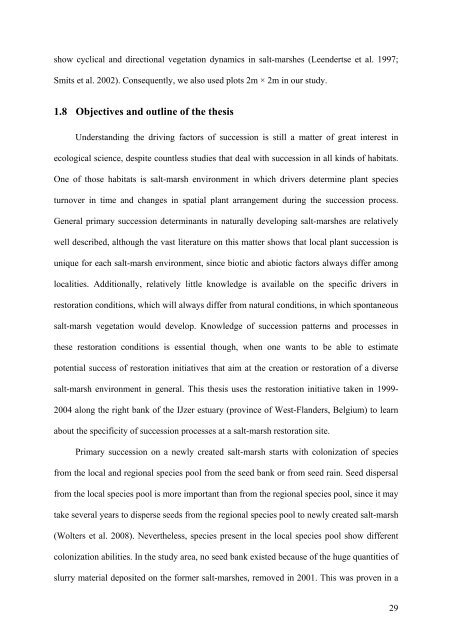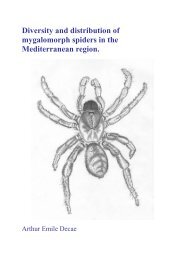PhD Reza Erfanzadeh 2009 - Ghent Ecology - Universiteit Gent
PhD Reza Erfanzadeh 2009 - Ghent Ecology - Universiteit Gent
PhD Reza Erfanzadeh 2009 - Ghent Ecology - Universiteit Gent
You also want an ePaper? Increase the reach of your titles
YUMPU automatically turns print PDFs into web optimized ePapers that Google loves.
show cyclical and directional vegetation dynamics in salt-marshes (Leendertse et al. 1997;<br />
Smits et al. 2002). Consequently, we also used plots 2m × 2m in our study.<br />
1.8 Objectives and outline of the thesis<br />
Understanding the driving factors of succession is still a matter of great interest in<br />
ecological science, despite countless studies that deal with succession in all kinds of habitats.<br />
One of those habitats is salt-marsh environment in which drivers determine plant species<br />
turnover in time and changes in spatial plant arrangement during the succession process.<br />
General primary succession determinants in naturally developing salt-marshes are relatively<br />
well described, although the vast literature on this matter shows that local plant succession is<br />
unique for each salt-marsh environment, since biotic and abiotic factors always differ among<br />
localities. Additionally, relatively little knowledge is available on the specific drivers in<br />
restoration conditions, which will always differ from natural conditions, in which spontaneous<br />
salt-marsh vegetation would develop. Knowledge of succession patterns and processes in<br />
these restoration conditions is essential though, when one wants to be able to estimate<br />
potential success of restoration initiatives that aim at the creation or restoration of a diverse<br />
salt-marsh environment in general. This thesis uses the restoration initiative taken in 1999-<br />
2004 along the right bank of the IJzer estuary (province of West-Flanders, Belgium) to learn<br />
about the specificity of succession processes at a salt-marsh restoration site.<br />
Primary succession on a newly created salt-marsh starts with colonization of species<br />
from the local and regional species pool from the seed bank or from seed rain. Seed dispersal<br />
from the local species pool is more important than from the regional species pool, since it may<br />
take several years to disperse seeds from the regional species pool to newly created salt-marsh<br />
(Wolters et al. 2008). Nevertheless, species present in the local species pool show different<br />
colonization abilities. In the study area, no seed bank existed because of the huge quantities of<br />
slurry material deposited on the former salt-marshes, removed in 2001. This was proven in a<br />
29










